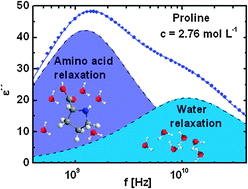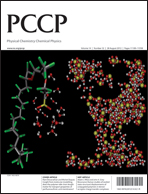Dielectric spectroscopy in the GHz region on fully hydrated zwitterionic amino acids†
Abstract
The complex dielectric permittivity of eight different amino acids in water solutions was determined in the frequency range from 0.2 to 20 GHz at room temperature, trying to span the whole range of solubility in each case. Two relaxations were observed at room temperature in this frequency range, which can be mainly assigned to the rotation of amino acids in the aqueous environment, and the reorientational motion of water molecules, respectively. Although the amino acids have a charged (zwitterionic) nature with huge dipole moments, the tendency towards dipolar alignment seems to be very weak, over the investigated concentration ranges. For these small bio-molecules, water screens solute–solute interactions and amino acids remain typically as isolated hydrated monomers. The dielectric results were used to estimate the number of water molecules restrained by each solute molecule. Finally, the comparison between the amino acid relaxation times made it possible to discuss the relationship between rotational dynamics and the structure and hydrodynamic coupling of the amino acid studied.


 Please wait while we load your content...
Please wait while we load your content...